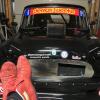
Has Anyone Ever Removed The Rear Seat? If So Why Not?
#1

Posted 19 February 2016 - 07:37 AM
If it had a full cage it should be structural?
Any photos of it been done?
Thanks
#2

Posted 19 February 2016 - 08:13 AM
do you really want the fuel tank in the cabin.
#3

Posted 19 February 2016 - 08:45 AM
#4

Posted 19 February 2016 - 08:57 AM
#5

Posted 19 February 2016 - 08:58 AM
There was a rule/law/regulation stating that there needed to be a divide between fuel tank and passenger cabin. I did find this link not the one I've found before but gives an indication.
I looked it up once because I bought a mini with the seat cut out and investigated to see what I could do. Previous owner had some metal panels that fixed from top of shelf to just behind seats with a thick bar going across the back.
#6

Posted 19 February 2016 - 09:11 AM
The Mini bodyshell is a monocoque so every part in the shell counts. Although there is some redundancy cutting out big chunks is not a good idea if you want to retain structural integrity.
#7

Posted 19 February 2016 - 09:14 AM
There was an old rally mini back in the 70's that had the whole of that section cut out and a very advanced (for the time!) spaceframe / rollcage put in to tie up all the suspension points......think he had a rear beam of some sort also. He moved the fuel tank to where the rear bench is but had it all firewalled with ally.
There is a fair amount of strength in the rear seat back, seat and parcel shelf, so before you go about getting to twitchy with the grinder, make sure you know what you are doing otherwise the shell could be scrap.
And the fuel tank issue is a whole different ball game and serious safety issue.
#8

Posted 19 February 2016 - 10:21 AM
Has anyone ever cut out the rear seat and parcel shelf?
If it had a full cage it should be structural?
Any photos of it been done?
Thanks
You need to read the FIA/MSA regulations for the branch of motorsport the car is to be used for. They may allow re-positioning of fuel tanks with suitable protection/fireproofing or they may not. With a lot of historic motor sport there is a requirement to use the original tank size and positions and there is always a requirement to fully fireproof the tank from the interior of the car.
#9

Posted 19 February 2016 - 11:58 AM
#10

Posted 19 February 2016 - 12:49 PM
There is a gap down the side so it's not sealed anyway but I wouldn't do it unless there was a specific reason to.
For all UK motor-sport that gap has to be filled with a fuel resistant material. Most of us use a GRP filler paste, like 'P38 Hole Bridge', which is acceptable.
You wouldn't find such a gap between fuel area and interior in current designs. Just shows how unsafe old cars are.
By the way, the battery would also need to be in a sealed container as well.
Edited by Cooperman, 19 February 2016 - 12:50 PM.
#11

Posted 19 February 2016 - 03:43 PM
I don't remember the OP talking about using it for any form of motorsport. Why are you assuming and giving advice when you don't know why he is asking.
#12

Posted 19 February 2016 - 05:51 PM
Because it is hard to think of a reason for wanting to delete any part of the monocoque unless it is to save weight and thus improve acceleration to get better lap or special stage times. Why else would this be done to a classic car?
I must say I hadn't thought that it could be for any other reason.
#13

Posted 19 February 2016 - 06:06 PM
I don't remember the OP talking about using it for any form of motorsport. Why are you assuming and giving advice when you don't know why he is asking.
#14

Posted 19 February 2016 - 10:24 PM
It 's not unusual (as Tom Jones said) to use aluminium sheet to replace a rear seat upright panel. I did it on a 1964 Triumph 2000 rally project a few years ago and my son is, this weekend, fitting an aluminium panel to his Escort Mk.2 RS2000 rally project.
It is allowable under the regulations as it was a period modification and it ensures the boot is fireproofed. With both of those cars (Triumph &n Escort) the saving of weight, especially from the back, is valuable and I lightened the Triumph any way I could. The roll cage puts back the strength in any case. The Escort is having a competition fuel tank across the boot and will carry two spare wheels, so it must be lightened as much as possible. The cage (Safety Devices) is also comprehensive and thus heavy.
The OP did mention a full cage and serious weight saving need, so one would assume it is for some serious competition. But one has to be careful with historic cars as the regulations are a bit strict unless it's for hill-climbs, in which case I believe there are more relaxed classes (not a hill-climb expert).
But why anyone would do this on a non-competition car is quite beyond me. Cage & weight saving of a serious kind = racing or rallying.
#15

Posted 19 February 2016 - 11:04 PM
Radford hatchback would be the obvious example of this:

http://www.aronline....rd-conversions/
Wasn't it done for a beatle to fit drums in the back?
It appears thats running twin tanks and blocked off some how.
1 user(s) are reading this topic
0 members, 1 guests, 0 anonymous users





















